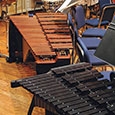.jpg)
After a recent performance at a band festival, I was reminded of the critical importance of preparing percussionists to perform in a new space. We had not performed at this festival in a few years, and I had forgotten how live the stage would be. Several evaluators noted percussion struggles throughout our performance, and although I talked to the percussionists before performing, they were unable to adjust as much as needed in the moment. Indeed, percussionists need to make these adjustments weeks ahead of the performance to ingrain the correct muscle and auditory memory.
Music festival spaces typically require a more nuanced and sensitive approach to playing percussion. Simply put, percussionists must play quieter. The acoustics in rehearsal spaces are ideally dry, so every last detail can be identified and corrected prior to the performance. By design, performance spaces are often more reverberant than practice spaces, whether it be a school gymnasium or a concert hall. As a result, percussion volumes that may seem appropriate in a rehearsal room can quickly become problematic in a performance space.
When possible, be sure to listen from the audience perspective to other ensemble performances in the same hall. Sometimes, it may only be possible for the director to have this opportunity beforehand, but ideally, the entire ensemble should hear other performances. Talk to other directors who have experience playing in the hall. Notice which instruments in particular may be problematic. In some halls, only the battery equipment, such as suspended cymbal, snare, or timpani, will overwhelm the ensemble sound. In other spaces, even auxiliary percussion, such as tambourine and claves, can quickly become too loud. Mallet instruments can also become problematic depending upon mallet choice.
The goal is to find a happy middle ground. I have heard performances in which the winds sound amazing, but the percussion section has been minimized to the point of almost being inaudible. It is important that the percussion instruments appropriately contribute to the excitement of the performance; certainly, the composer intended the percussion to be heard as well. Finding this middle ground is the essence of a great performance.
Percussionists must be taught proper playing techniques. One of the first things I emphasize is the bell-shaped crescendo. A trumpet bell is relatively narrow until it flares right at the end, and percussionists should shape their crescendos the same way on all battery equipment. This ensures that the ensemble can easily be heard and provides just the right dramatic sweep of energy at the end of the phrase. However, on suspended cymbal, make sure that a player is producing enough vibration initially to hear a soft roll. Frequently, suspended cymbal rolls can only be heard at louder dynamic levels or at the end of a crescendo.
It also important for percussionists to hold auxiliary equipment, such as triangle or tambourine, above the tops of their music stands. This way, the instrument’s sound will project to the audience. Also, this makes it easy for the director to ascertain whether the player is using correct technique. The sound of an instrument that is obscured behind a stand will be diminished, both in terms of tonal quality and overall volume. Remind percussionists that audiences hear with their eyes.
The quality of the percussion instruments provided, and the mallets used on them, also have a profound effect on the sounds achieved and the ways in which they are projected. The quality of large percussion instruments varies widely at festivals, and it is something that percussionists have little control over. Bring as much of your own equipment as is feasible, so percussionists feel comfortable and know what they can expect to hear. Encourage percussionists to play on new equipment prior to the performance if time permits. This is especially helpful if a dress rehearsal in the performance space is not possible. In particular, have them test out the playing zones on bass drum and tam-tam, as these instruments seem to vary the most. Make sure your percussionists know how to tune the timpani without pre-marked gauges; there is no guarantee that tuning gauges will be on the festival timpani.
Mallet and stick choice, however, is absolutely something percussionists can plan for in any performance. Encourage percussionists to continue to build their stick bags every year. I ask young percussionists to buy larger stick bags and tell them that we are planning ahead for all of the mallets that they will eventually own. Relative to larger instrument purchases, mallets are an inexpensive, but worthwhile investment. Be sure to purchase a variety of any mallets that are typically provided by the school, such as bass drum beaters, triangle beaters, or bell mallets.
Muffling can also be critical in performance. Make sure percussionists bring a large towel that can be used to dampen the bass drum by draping it over the top. The amount of ring on a snare drum can be altered significantly by placing a plastic card (such as a student ID or credit card) on the beater head. Plastic rings that fit around the inside rim of the drum can also be used, as can a wallet. For concert toms, placing masking tape or something similar on the head can help eliminate extra ring. You can also use silicone squares that adhere to the head but are easily removed, such as Moon Gel.
Just as dynamic levels must be adjusted in the winds to achieve correct balances, so must the levels be adjusted in the percussion section. I am wary of any dynamic marking above fortissimo. Wind players can only play so loudly before their tone is compromised and becomes distorted; many percussion instruments, however, can be played at extremely loud dynamic levels while still producing a basically characteristic sound. This is why percussion instruments can completely overpower an ensemble. Dynamic levels should be adjusted according to each percussion instrument, not just across the board. If you are unsure whether you have achieved the right balance, record the ensemble to hear how it sounds in playback. When in doubt, always ask percussionists to play more conservatively.
In performance, too, it can be difficult to ascertain the percussion balance on the podium. Typically, I tell the wind players not to react in the moment to how they sound in a new space, but rather, to simply play the same way they have been practicing. With percussionists, however, I ask them to very critically monitor what they are hearing and make nuanced adjustments. In a new space, I find myself giving percussionists feedback regarding balance through conducting gestures more often than the winds.
Vertical alignment can also be deceptive in a new space, which can result in phasing problems. I teach players to listen back for pulse. This means that the percussion section and low winds are most directly responsible for establishing the ensemble pulse. All other winds must listen through the band to correctly align their rhythms with the percussion and low winds. I frequently have wind players identify what percussion instrument to listen for and write it on their parts. Conversely, percussionists must learn to play slightly ahead of what they hear from the winds, otherwise their sound will arrive late. This becomes even more critical in a new performance space. Percussionists must watch the conductor carefully and frequently will have to ignore the pulse they hear. Echoes from the concert hall can be particularly deceptive for the players and conductor alike.
Percussionists must be held accountable for the same level of performance excellence as the winds. Mallory Thompson at Northwestern University leads by example in this respect, often giving percussionists detailed requests in rehearsals and clinics. I can vividly remember the first time she worked with my band at a festival. We had been working on Rocky Point Holiday for just a few weeks, and the winds were progressing at a much faster rate than the percussion section. She lovingly but firmly made them aware of this discrepancy. Make sure you give percussionists consistent feedback in rehearsals so they can make informed decisions in performance. Many poor decisions during performances are caused by inadequate rehearsal.
Finally, make sure percussionists have a clear plan for transporting all of the necessary equipment and understand the time constraints of the performance. Create a comprehensive packing list and assign each piece to individual players. Be sure to label all equipment that will be used, along with the bags and cases used to transport everything. Help percussionists determine what equipment should be pre-assembled and what equipment would be better assembled on the performance stage. If possible, assign a director and multiple adults to assist the percussionists with set up and tear down.
Most festivals require a set-up diagram in advance, but make sure all equipment is in the same physical locations on the performance stage as expected, so the percussionists and director know where everything is during the actual performance. Nothing can ruin a performance faster than the percussion section not being ready and then scrambling during the performance to find correct equipment. Practice a full runthrough of the performance prior to the festival, so percussionists get a sense of the pacing required for resets between pieces. Although time consuming, helping percussionists plan for their performance at festival will dramatically improve the musical results for everyone involved.






